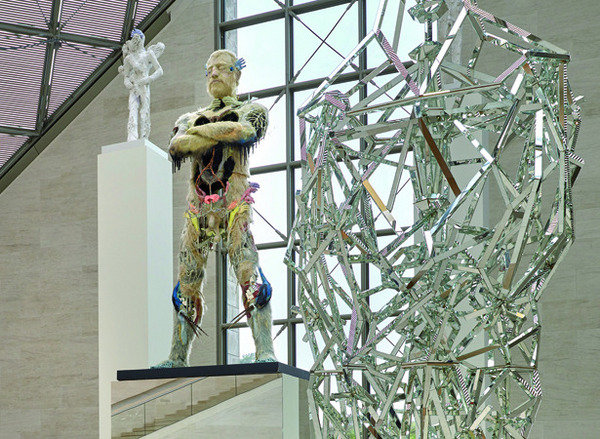Tree Exhibition
dal 5/3/2015 al 30/5/2015
Segnalato da
David Altmejd
David Birkin
Broomberg & Chanarin
Antony Cairns
Vera Frenkel
Tatiana Lecomte
Gabor Osz
Franz Erhard Walther
Marie NoElle Farcy
CafE Creme asbl
5/3/2015
Tree Exhibition
Musee d'Art Moderne Grand-Duc Jean - Mudam, Luxembourg
David Altmejd presents his figurative sculptures and the Plexiglas installations. Franz Erhard Walther presents the works he produced up to 1969 using this technique were to be collected in the so-called 1. 'Memory Lab - Photography challenges History' addresses the theme of photographic memory.

David Altmejd
Curated by: Marie-Noëlle Farcy
David Altmejd's art is that of a sculptor. In the some 15 years of his career, this Canadian artist has produced a wide variety of sculptures that are absolutely contemporary in the choice of their materials. The great diversity and surprising originality in the material composition of his works is coupled with a formal and thematic complexity that derives from classical sculpture, while also bearing an affinity to the dreamlike-nightmarish artistic worlds of Matthew Barney, the fantastic films of David Cronenberg, David Lynch and Jim Henson, or the labyrinthine narrations of Jorge Luis Borges. In Altmejd's work, the grotesque combines with the terrible. In his figurative sculptures and the Plexiglas installations, his interest in biology and architecture, along with his fascination with metamorphosis, leads to strong, strange images with a sometimes overwhelming wealth of detail.
In the artist's view, this lends a formal momentum to individual elements, which in some works seem to be created from within themselves. Altmejd's works, informed throughout by inner forces and taut energy, seem like a snapshot of a single moment within a continual process of evolution. The natural forces variously depicted in the sculptures are opposed by currents of energy symbolised in the Plexiglas boxes by gold chains and bundles of threads. The works thus possess an undefined narrative element of disturbing ambiguity that confronts the viewer with many unanswered questions, but at the same time validates the subjectivity of his or her own feelings and interpretations. David Altmejd was born in Montreal, Canada, in 1974. He lives and works in New York, USA
----
Franz Erhard Walther
Curated by: Marie-Noëlle Farcy
Franz Erhard Walther's concept of the artwork as such developed from the late 1950s, at a time when many artists were starting to question the parameters of art. Traditional forms of art were not capable of expressing Walther's artistic aspirations at the time; he found it more interesting to examine material processes, action and even modes of exhibition as components in the definition of an artwork.
Thus, according to Walther's concept, art had an immaterial, performative character and took place within the individual physical and mental processes enacted by those encountering particular works. The role of the artist shifted from being the creator of works with a particular meaning to becoming the mere facilitator of a conscious and personal experiencing of aesthetic phenomena. This tendency had already been adumbrated in early actions such as Versuch, eine Plastik zu sein (Trying to be a sculpture, 1958), and, after many years in which Walther experimented with a variety of materials, led finally in 1963 to the discovery of the technique of sewing, a working method that met Walther's need for formal rigour. The works he produced up to 1969 using this technique were to be collected in the so-called 1. Werksatz (First Work Set). The 58 individual works sewn from sturdy fabric that comprise the 1. Werksatz, which Walther called “Werkstücke” (Work pieces) or “Handlungsstücke” (Action pieces), were for him simply “forms” that prescribed concrete patterns of action and were reliant on being actually handled by one or several participants for attaining the character of an artwork, a character that remained bound to the action itself.
----
Memory Lab - Photography challenges History
Curated by: Café Créme asbl
Memory Lab - Photography challenges History addresses the theme of photographic memory. How does the contemporary photographer approach the past, including the events that characterize Europe and its history, the world wars and the conflict in the Balkans and elsewhere? Beyond the desire to revive the memory of those cruel periods, the inability to “tell” the event through “photography” becomes ironic distancing or takes refuge in the personal journal, in a very particular subjectivity in which sensitivity outweighs the desire to document things in a quasi-scientific way. Photography abandoned its inviolable status as a witness to facts a long time ago and the contemporary approach combines in different ways a whole new personal sensitivity that characterizes the younger generation with a no less insistent reminder that history is bound to repeat itself
Image: Vue de l’exposition David Altmejd . Flux, 13.12.2014 – 31.05.2015, Mudam Luxembourg, © Photo: Rémi Villaggi / Mudam Luxembourg
Press Contact:
Valerio D’Alimonte tel. +352 45 3785-633 mob. +352 691432896 v.dalimonte@mudam.lu
Opening: Friday 6 March, 6pm
Mudam Luxembourg
Musée d'Art Moderne Grand-Duc Jean
3, Park Dräi Eechelen
L-1499 Luxembourg-Kirchberg
Opening hours
Wednesday to Friday: 11am - 8pm
Saturday to Monday: 11am - 6pm
Bank holidays 11am - 6pm
Closed on Tuesday and on 25.12.
Entrance fee
Adults: 7€
< 26 years & groups (min. 15 persons): 5€
< 21 years, students < 26 years, Wednesday 6pm - 8pm: free entrance



